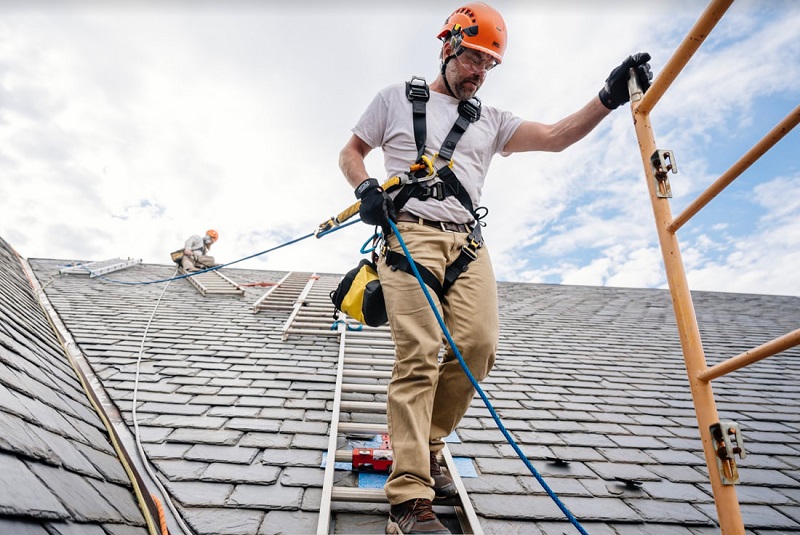Working on a roof comes with inherent risks, but with the right precautions, these risks can be minimized. Whether you’re a professional roofer or a homeowner attempting a DIY project, prioritizing safety is paramount. In this guide, we’ll share eight essential tips to help you avoid falls and injuries while working on a roof.
1. Wear Appropriate Safety Gear
Before ascending a roof, ensure you’re equipped with the proper safety gear. This includes a sturdy harness, non-slip footwear, a hard hat, and gloves. These items provide essential protection against slips, trips, and potential falls.
2. Check Weather Conditions
Always check the weather forecast before working on a roof. Avoid working on a wet or icy surface, as this significantly increases the risk of accidents. If adverse weather conditions are anticipated, postpone the task to a safer day.
3. Use Stable Ladders
Ensure the ladder you use is in good condition and is the appropriate height for the task. Set it on stable ground, and if necessary, use ladder stabilizers or standoffs to prevent it from shifting or damaging the gutters.
4. Mind the Weight Limits
Roofs have weight limits, especially those with fragile or aging materials. Be aware of these limits and avoid placing excessive weight in one area. Distribute your weight evenly, and use boards or planks to create a stable surface if needed.
5. Secure Tools and Equipment
Ensure all tools and equipment are properly secured to prevent them from sliding off the roof. Use tool belts or tethering systems to keep items within reach without the risk of them falling.
6. Be Cautious Near Edges
Exercise extreme caution when working near the edges of a roof. Avoid leaning over, and always maintain a firm footing. Consider using safety cones or barriers to mark the perimeter and provide a visual reminder.
7. Take Breaks and Hydrate
Working on a roof can be physically demanding. Take regular breaks to rest and rehydrate, especially on hot days. Fatigue can impair judgment and coordination, increasing the risk of accidents.
8. Seek Professional Help When Needed
Some roofing tasks, such as major repairs or installations, are best left to professionals. If you’re unsure about the safety of a task or lack experience, consider hiring a licensed roofing contractor to ensure the job is done safely and correctly.
FAQs
Q: Can I work on a roof alone?
A: It’s recommended to have a spotter or someone nearby when working on a roof for added safety. In complex or high-risk tasks, professional assistance may be necessary.
Q: How do I know if my roof can support my weight?
A: Consult a structural engineer or roofing professional to assess the load-bearing capacity of your roof. They can provide specific recommendations based on your roof’s construction.
Q: What should I do if I encounter an unexpected hazard on the roof?
A: Stop work immediately and assess the situation. If it poses a significant risk, consider contacting a professional to address the hazard before continuing.
Q: Are there specific safety regulations for roofing work?
A: Yes, various safety regulations and standards govern roofing work. Familiarize yourself with local and national regulations to ensure compliance.
Q: Can I use a regular ladder on a roof?
A: It’s recommended to use a specialized roof ladder or ladder stabilizers designed for safe roof access. These provide added stability and prevent damage to the roof surface.
Q: What should I do if I feel unsteady or uncomfortable while on the roof?
A: Trust your instincts. If you feel unsafe, descend from the roof immediately and reassess the situation. Never compromise safety for the sake of completing a task.
Conclusion
Prioritizing safety when working on a roof is crucial for preventing accidents and injuries. By following these essential tips, you can ensure a safer work environment and protect both yourself and your property. Remember, when in doubt, seek professional assistance to ensure the task is completed safely and efficiently.






